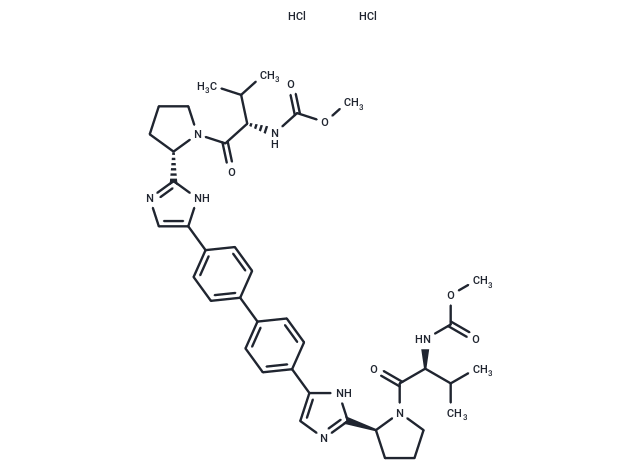Shopping Cart
- Remove All
 Your shopping cart is currently empty
Your shopping cart is currently empty

Daclatasvir dihydrochloride (BMS-790052 dihydrochloride) is an orally available antiviral agent that inhibits the NS5A region of the hepatitis C virus (HCV) and is used in combination with other oral antivirals to treat chronic hepatitis C. Elevations in serum enzyme levels during daclatasvir therapy are uncommon, and it has not been convincingly implicated in cases of clinically apparent liver injury with jaundice.

| Pack Size | Price | Availability | Quantity |
|---|---|---|---|
| 5 mg | $35 | In Stock | |
| 10 mg | $43 | In Stock | |
| 25 mg | $55 | In Stock | |
| 50 mg | $65 | In Stock | |
| 100 mg | $74 | In Stock | |
| 500 mg | $173 | In Stock | |
| 1 g | $256 | In Stock | |
| 1 mL x 10 mM (in DMSO) | $44 | In Stock |
| Description | Daclatasvir dihydrochloride (BMS-790052 dihydrochloride) is an orally available antiviral agent that inhibits the NS5A region of the hepatitis C virus (HCV) and is used in combination with other oral antivirals to treat chronic hepatitis C. Elevations in serum enzyme levels during daclatasvir therapy are uncommon, and it has not been convincingly implicated in cases of clinically apparent liver injury with jaundice. |
| Targets&IC50 | OATP1B:1.5 µM (IC50), OCI:3.27 µM (IC50), HCV 2a:71 pM (EC50), HCV 1a:50 pM (EC50), HCV 3a:146 pM (EC50), HCV 5a:33 pM (EC50), NS5A26-202:210 nM (Kd), NS5A33-202:8 nM (Kd), HCV 4a:12 pM (EC50), HCV 1b:9 pM (EC50) |
| Kinase Assay | CDK assays are performed in 96-well filter plates. All CDK-cyclin kinase complexes are expressed in insect cells through baculovirus infection and purified. The substrate for the assays is a fragment (amino acids 792-928) of pRb fused to GST (GST·RB-Cterm). The total volume in each well is 0.1 mL containing a final concentration of 20 mM Tris-HCl, pH 7.4, 50 mM NaCl, 1 mM dithiothreitol, 10 mM MgCl2, 25 μM ATP (for CDK4-cyclin D1, CDK6-cyclin D2, and CDK6-cyclin D3) or 12 μM ATP (for CDK2-cyclin E, CDK2-cyclin A, and CDC2-cyclin B) containing 0.25 μCi of [γ-32P]ATP, 20 ng of enzyme, 1 μg of GST·RB-Cterm, and Palbociclib (0.001-0.1 μM). All components except the [γ-32P]ATP are added to the wells, and the plate is placed on a plate mixer for 2 min. The reaction is started by adding the [γ-32P]ATP and the plate is incubated at 25°C for 15 min. The reaction is terminated by addition of 0.1 mL of 20% trichloroacetic acid and the plate is kept at 4°C for at least 1 hour to allow the substrate to precipitate. The wells are then washed 5 times with 0.2 mL of 10% trichloroacetic acid and radioactive incorporation is determined with a β plate counter. |
| Alias | BMS-790052 dihydrochloride |
| Molecular Weight | 811.8 |
| Formula | C40H52Cl2N8O6 |
| Cas No. | 1009119-65-6 |
| Smiles | Cl.Cl.COC(=O)N[C@@H](C(C)C)C(=O)N1CCC[C@H]1c1ncc([nH]1)-c1ccc(cc1)-c1ccc(cc1)-c1cnc([nH]1)[C@@H]1CCCN1C(=O)[C@@H](NC(=O)OC)C(C)C |
| Relative Density. | no data available |
| Storage | Powder: -20°C for 3 years | In solvent: -80°C for 1 year | Shipping with blue ice/Shipping at ambient temperature. | ||||||||||||||||||||||||||||||
| Solubility Information | DMSO: 55 mg/mL (67.75 mM), Sonication is recommended. | ||||||||||||||||||||||||||||||
Solution Preparation Table | |||||||||||||||||||||||||||||||
DMSO
| |||||||||||||||||||||||||||||||

Copyright © 2015-2025 TargetMol Chemicals Inc. All Rights Reserved.